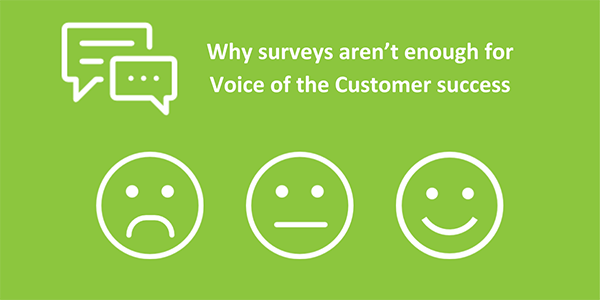Why surveys aren’t enough for Voice of the Customer success

Brands understand that they need to listen to their customers if they are to deliver an engaging experience that drives loyalty and long-term revenues. That’s why they have invested heavily in Voice of the Customer (VoC) programs that seek to collect and act on customer insight. For example, recent Eptica research found that 70% of brands have some sort of VoC program in place.
However, most existing VoC approaches rely on collecting customer feedback through surveys. Whether these are run over the phone, digitally or face-to-face they have significant drawbacks which limit their effectiveness:
1. They don’t reach everyone
Not everyone will have the time or inclination to complete a survey. Often, those that respond will be at either end of the spectrum – either very satisfied or very dissatisfied, giving a skewed view of what customers really feel. And we’ve all been in the position where an employee pushes us to fill in a survey after a good experience, hoping to get positive feedback that will boost their bonus. Surveys may also be carried out weeks or even months after an interaction has taken place, making it difficult for even the most helpful customer to respond accurately.
2. They are controlled by the company
The whole feedback process is governed by the brand – from the channel they use to send the survey, to the questions asked. It is not a true dialogue between equals, instead being structured very much on the brand’s terms. This means that it is easy to miss out on vital insight, simply because customers don’t have the opportunity to focus on what is important to them, but have to follow a series of standard questions.
3. They give an incomplete picture
Customer surveys are just one way that consumers provide feedback. They share their thoughts on social media and on review sites (indirect feedback), and also leave a digital trail across the customer journey, such as when navigating through your website or contacting you with questions (inferred feedback). You need to bring all three of these types of feedback together if you want to benefit from a complete picture of what your customers think about your brand. Surveys may also focus on a particular touchpoint or interaction, rather than the overall customer journey. Again, this gives an incomplete view – for example, a phone call may go well, but the next step in the journey then fails to deliver the right experience, causing the customer to leave. If you just look at the satisfaction with the phone call, you’ll miss the bigger picture.
4. They don’t capture emotion
Surveys are normally text-based, and often heavily structured around quantitative questions. But buying decisions and connections with brands are increasingly emotional – consumers want a personal relationship based on understanding and empathy. Even in free text answers to qualitative questions, most text analytics tools struggle to unlock key themes and topics as they rely on more basic keyword analysis. This limits the ability to drill down into individual responses and to understand the emotion behind them, reducing their effectiveness.
Because of these issues with surveys many VoC programs do a great job of telling you how happy your customers are, they don’t answer the big question of why they feel the way that they do. That means it is impossible for brands to use this insight to directly improve the experience and their operations, and therefore drive greater revenues and return on investment.
Customers are increasingly demanding – but at the same time now provide huge amounts of data that can be used to design an experience that meets these demands. For brands to be successful, they therefore need to look beyond surveys to listen to the entire voice of their customers and use this insight to drive real, tangible improvements across the business.






